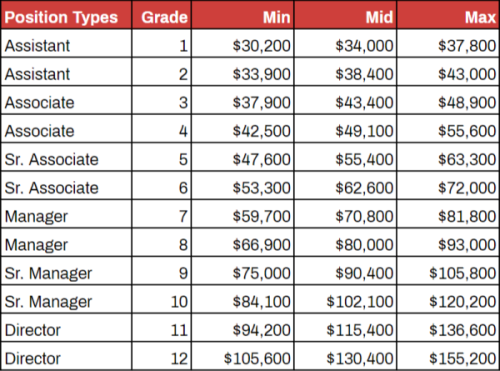| title | date | Intro Text | Page Link | layout | ||||||
|---|---|---|---|---|---|---|---|---|---|---|
HOT Salary Framework |
2019-03-29 20:14:00 UTC |
HOT is passionate about transparency and equity. Two years ago, HOT chose to be more transparent about salaries - for both new and existing staff - by rolling out a published salary framework in January 2019. Since then, we have learned a lot. We realized that some of our sources for salaries and cost of living were not as accurate as we wanted. We discovered that individual salary calculations were still confusing to staff and needed to be more transparent. We also learned that our global organization is complex, with remote staff from dozens of countries and numerous legal systems and markets. |
|
page |
Starting in mid-2020, we undertook a review to ensure our framework is transparent, fair, and meets the demands of a complex, international workforce. We did not throw the first framework out the window. On the contrary, we found it provided the necessary structure for determining salaries but needed tweaking and additional resources behind it.
Our goals around compensation have not changed - we still want to ensure a consistent and equitable process for all staff, regardless of position, location, gender, or any other distinguishing characteristic. We are always learning in this process and will continue to make adjustments to ensure fairness.
The HOT Salary Framework is based upon a formula made up of four factors that, when multiplied together, determine a HOT employee’s annual salary or contractor’s hourly rate.
The “Role Base Salary” is a number in USD that serves as the benchmark salary for each position in our organization. HOT partners with PayScale.com to get accurate, US national market-based salary data benchmarked to organizations sized at 150 staff in the non-profit humanitarian sector. Working with the Insight Lab at PayScale, we created our first-ever salary structure (all in USD):
HOT Salary Scale [in USD prior to application of location and non-profit multipliers]
Each role falls within a specific grade on the scale above, identified between the hiring manager and the finance team at the creation of the position. Certain job levels include more than one grade, which allows for additional staff growth in those roles. From now on, each position posted on hotosm.org will include the relevant grade from our scale.
Next, the “Role Base Salary” amount is calculated at the 50th percentile of the market within Payscale’s Insight Lab platform by comparing that role to similar positions based on the job description. Note that Payscale.com publishes salaries publicly based on job title; these may not reflect the calculated salaries based on job description (not job title), career level, specific skills, level of supervision, education, etc.
After choosing the “Role Base Salary,” we apply a nonprofit multiplier of 90% (transitioning to 95% in 2021) that we plan to eliminate gradually as our budget allows. Eventually, the “Role Base Salary” will be entirely reflected in the salary scale above.
The “Location Factor” aims to ensure staff members receive fair, comparable wages in relation to their peers at HOT, considering the relevant local market and costs. The “Location Factor” (now between 0.3 and 1.0) adjusts the “Role Base Salary” by taking into consideration: 1) the applicant pool of the position (national, regional, or global applicant pools are set at the start of the hiring process), and 2) the physical city location of the individual under consideration.*
HOT Location Factor Matrix
The source of our location bands now comes from:
- Birches Group data - for national and regional pools (NEW!)
- Numbeo.com - for global pools**
During our review process, the location factor was compressed from 5x from lowest to highest band to 3.3x from lowest to highest band. As HOT moves to a regional model, the difference will decrease even more to 2.5x from the lowest to the highest band.
- Staff are benchmarked against the closest major city to which they live. All benchmarking is compared to Washington, DC, which is HOT’s headquarters.
** We no longer use national level salary data sources, as those skewed our calculations for countries where the urban-rural economic divide was significant.
Deployed Staff and Digital Nomads
Deployed staff are placed within the “Global Applicant Pool - Home Country-based” or “Global Applicant Pool - Nomad” column, whichever is more advantageous for each individual.
Staff choosing to live outside of their ‘tax home’ are considered slightly differently from individuals living in their ‘tax home’ location. They fall into the “Global Applicant Pool - Nomad” category.
The “Personal Capital Factor” (between 1.0 and 1.25) factors in applicable skills, level of responsibility, and demonstrated achievements unique to each individual. The Personal Capital Factor is set by the hiring manager & hiring Director at the time of hire and approved by HOT’s Director of Finance & Operations to ensure consistency across the organization. The default level for new positions is 1.0.
“Additional Earnings” provides an additional 15% for contractors for whom HOT does not pay any local taxes or provide paid time off due to legal restrictions.
Beyond the Salary Framework, HOT provides additional support tailored to an individual’s location and type of contract. While staff may not receive the same support package as their peers in another location & situation, we work to ensure equity for everyone. The package includes:
- Healthy staff reimbursement or medical insurance options
- Paid time off, or a contractor differential
- Home office allowance for remote workers
- Equipment allowance based on justified need
- Relocation package for international staff moving to regional hubs
- Learning & development opportunities for all staff


